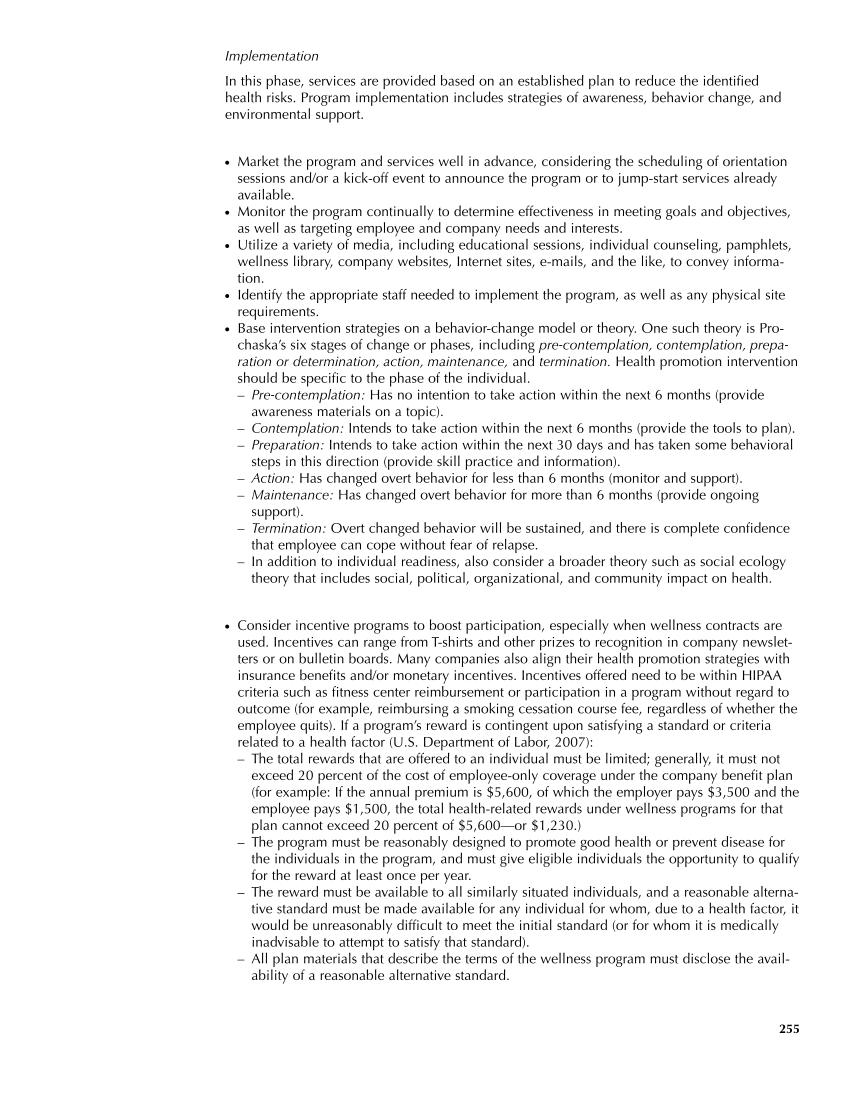Implementation In this phase, services are provided based on an established plan to reduce the identified health risks. Program implementation includes strategies of awareness, behavior change, and environmental support. ● Market the program and services well in advance, considering the scheduling of orientation sessions and/or a kick-off event to announce the program or to jump-start services already available. ● Monitor the program continually to determine effectiveness in meeting goals and objectives, as well as targeting employee and company needs and interests. ● Utilize a variety of media, including educational sessions, individual counseling, pamphlets, wellness library, company websites, Internet sites, e-mails, and the like, to convey informa- tion. ● Identify the appropriate staff needed to implement the program, as well as any physical site requirements. ● Base intervention strategies on a behavior-change model or theory. One such theory is Pro- chaska’s six stages of change or phases, including pre-contemplation, contemplation, prepa- ration or determination, action, maintenance, and termination. Health promotion intervention should be specific to the phase of the individual. – Pre-contemplation: Has no intention to take action within the next 6 months (provide awareness materials on a topic). – Contemplation: Intends to take action within the next 6 months (provide the tools to plan). – Preparation: Intends to take action within the next 30 days and has taken some behavioral steps in this direction (provide skill practice and information). – Action: Has changed overt behavior for less than 6 months (monitor and support). – Maintenance: Has changed overt behavior for more than 6 months (provide ongoing support). – Termination: Overt changed behavior will be sustained, and there is complete confidence that employee can cope without fear of relapse. – In addition to individual readiness, also consider a broader theory such as social ecology theory that includes social, political, organizational, and community impact on health. ● Consider incentive programs to boost participation, especially when wellness contracts are used. Incentives can range from T-shirts and other prizes to recognition in company newslet- ters or on bulletin boards. Many companies also align their health promotion strategies with insurance benefits and/or monetary incentives. Incentives offered need to be within HIPAA criteria such as fitness center reimbursement or participation in a program without regard to outcome (for example, reimbursing a smoking cessation course fee, regardless of whether the employee quits). If a program’s reward is contingent upon satisfying a standard or criteria related to a health factor (U.S. Department of Labor, 2007): – The total rewards that are offered to an individual must be limited generally, it must not exceed 20 percent of the cost of employee-only coverage under the company benefit plan (for example: If the annual premium is $5,600, of which the employer pays $3,500 and the employee pays $1,500, the total health-related rewards under wellness programs for that plan cannot exceed 20 percent of $5,600—or $1,230.) – The program must be reasonably designed to promote good health or prevent disease for the individuals in the program, and must give eligible individuals the opportunity to qualify for the reward at least once per year. – The reward must be available to all similarly situated individuals, and a reasonable alterna- tive standard must be made available for any individual for whom, due to a health factor, it would be unreasonably difficult to meet the initial standard (or for whom it is medically inadvisable to attempt to satisfy that standard). – All plan materials that describe the terms of the wellness program must disclose the avail- ability of a reasonable alternative standard. 255
Purchased from OEM Press by (ge corporate access). (C) 2013 OEM Health Information, Inc. All rights reserved.












































































































































































































































































































































































































































